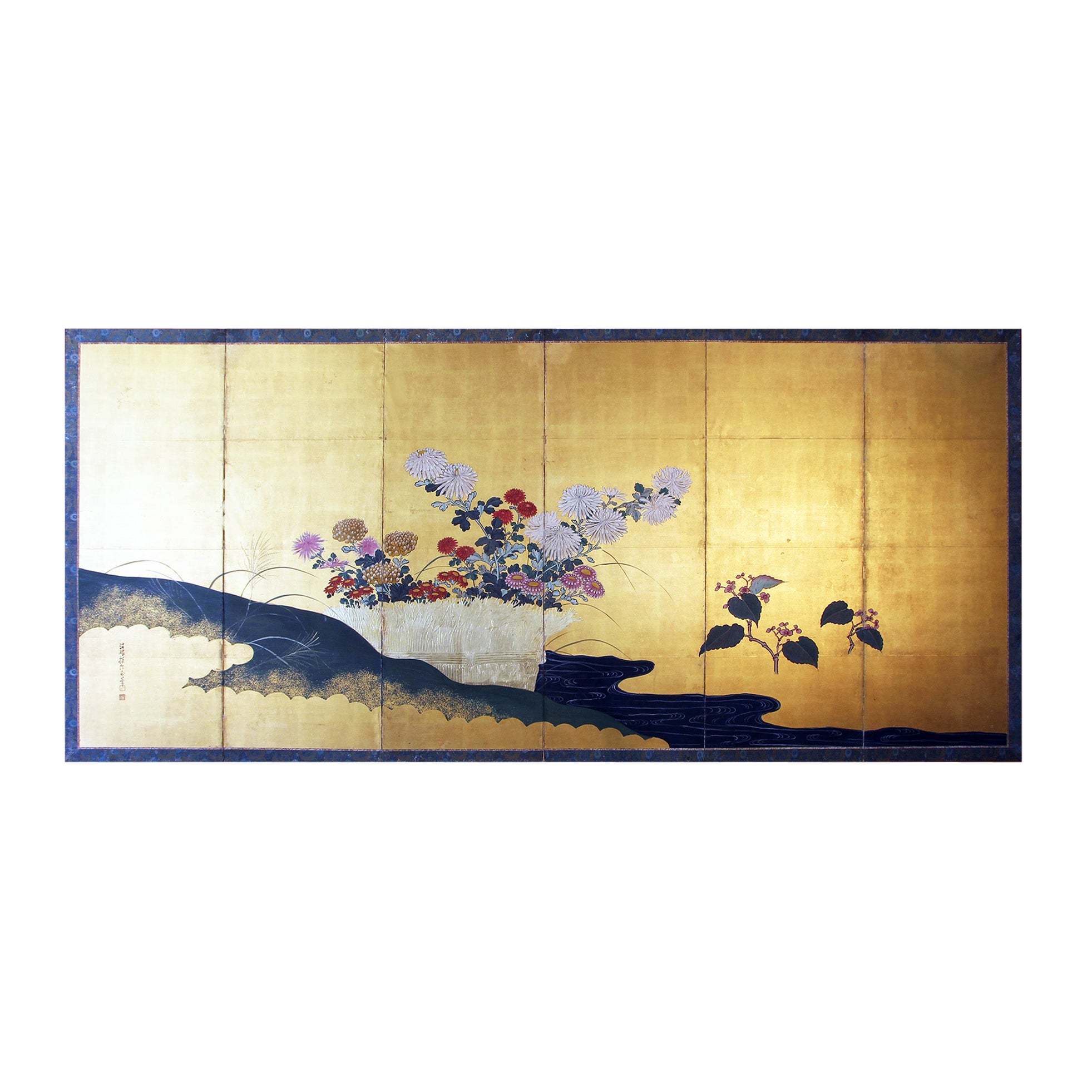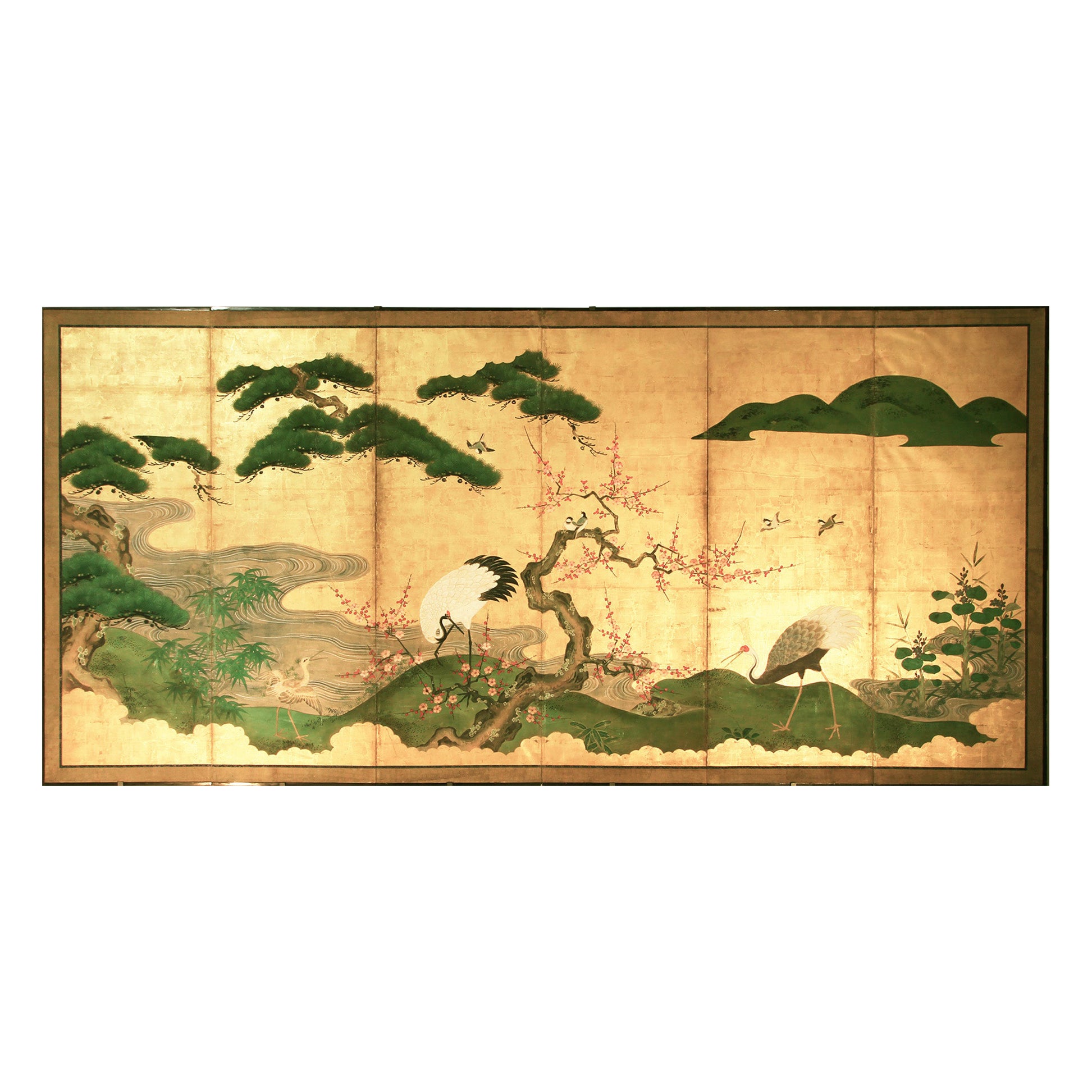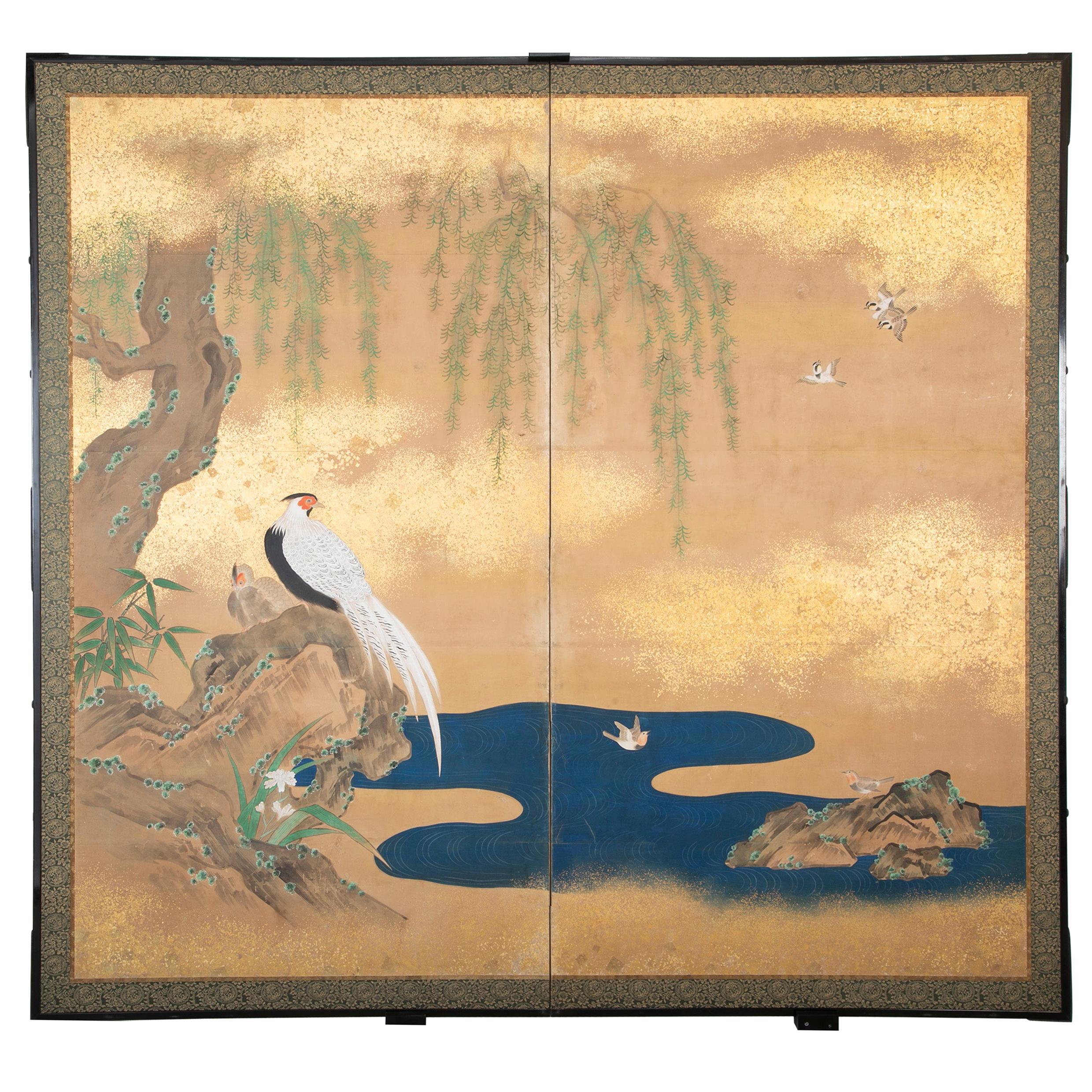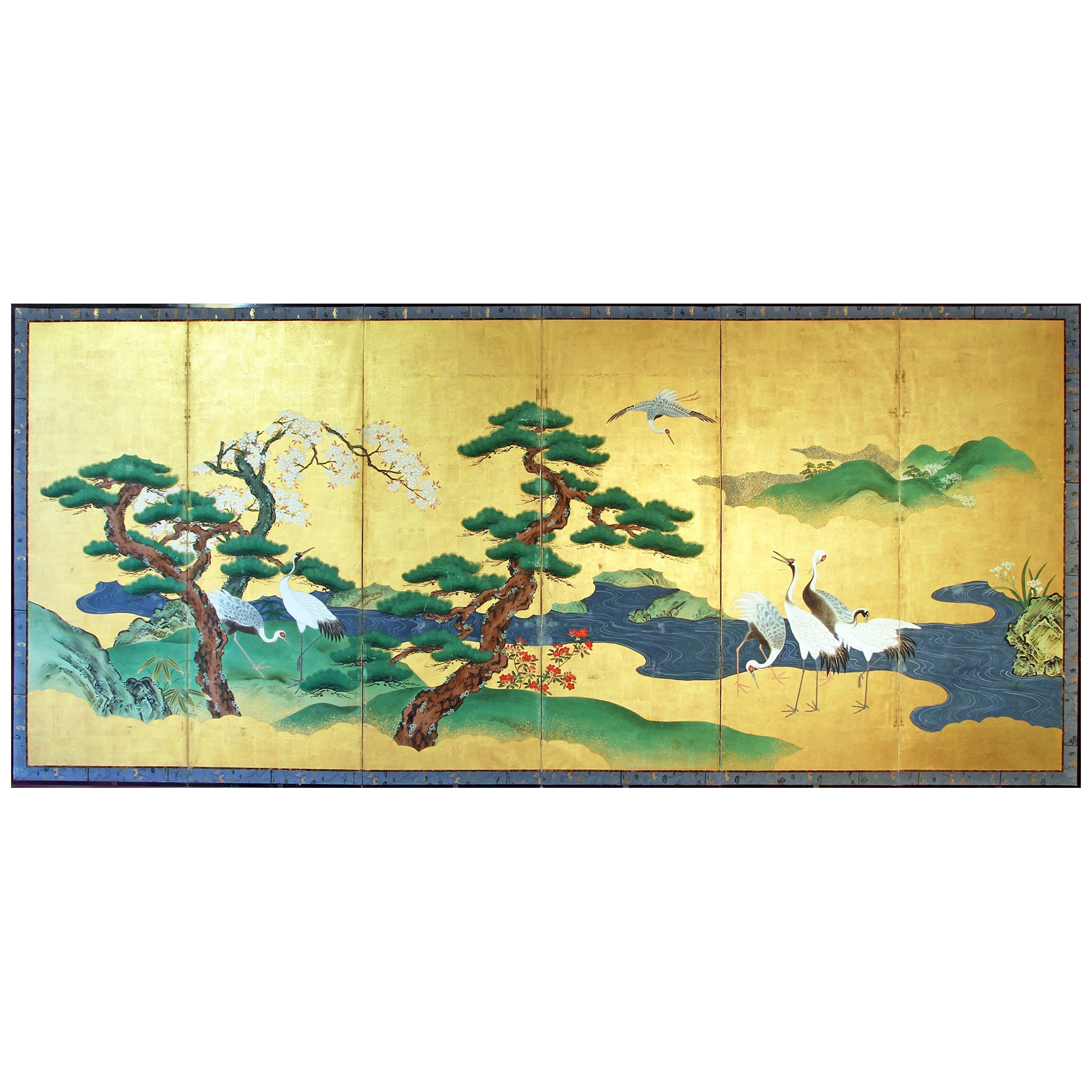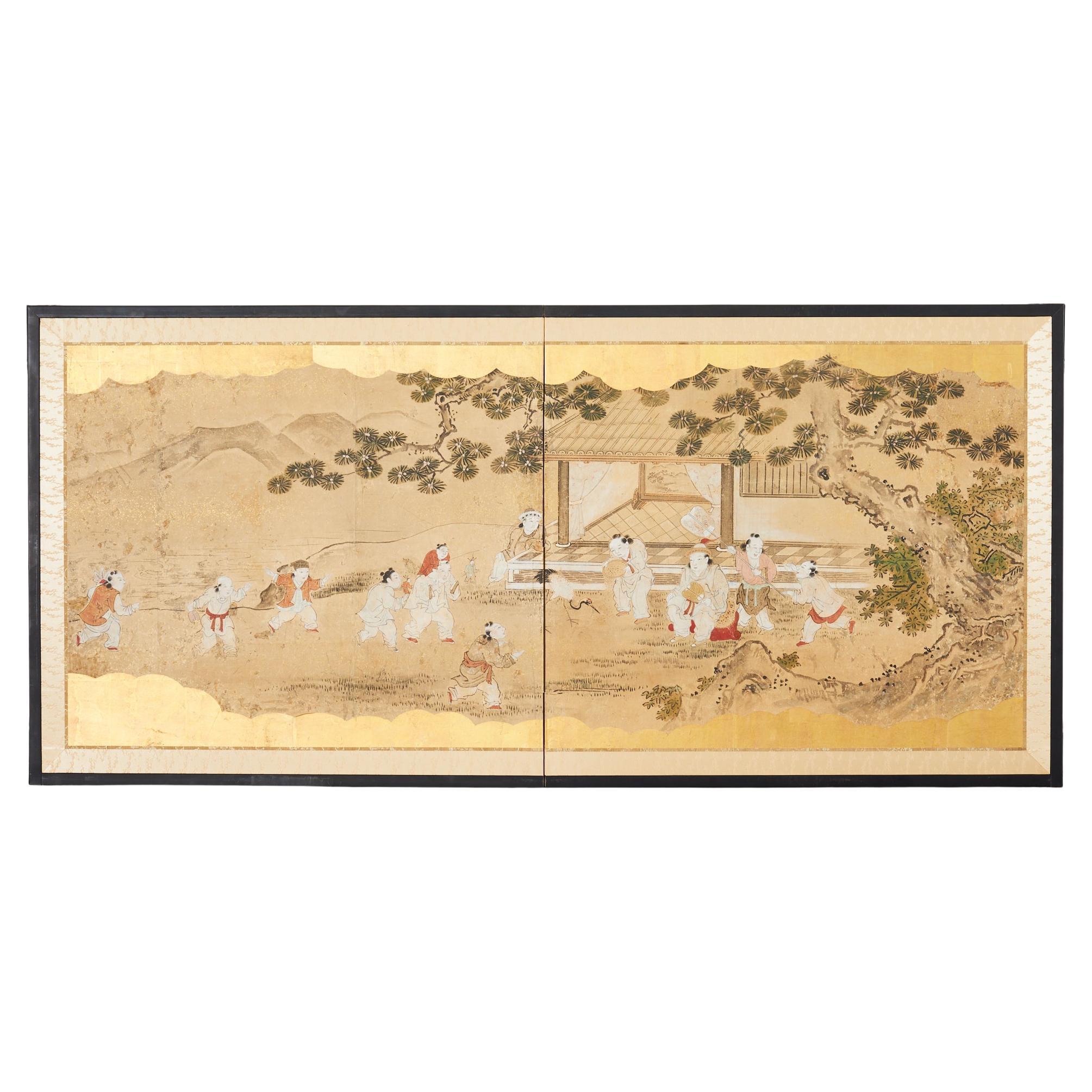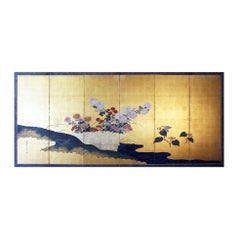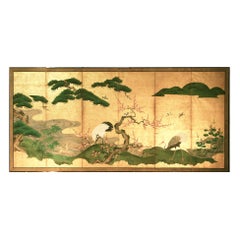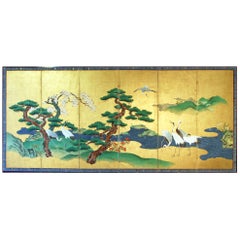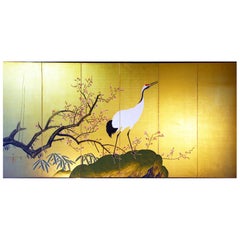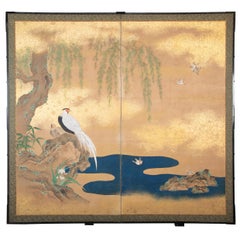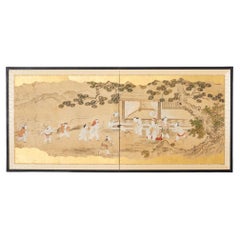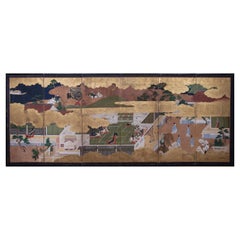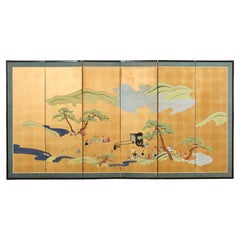Items Similar to 18°th Century Japanese Gold Leaf Screen
Want more images or videos?
Request additional images or videos from the seller
1 of 7
18°th Century Japanese Gold Leaf Screen
$10,312.94
£7,671.78
€8,600
CA$14,121.94
A$15,701.68
CHF 8,198.55
MX$191,127.63
NOK 104,609.91
SEK 98,014.49
DKK 65,467.05
Shipping
Retrieving quote...The 1stDibs Promise:
Authenticity Guarantee,
Money-Back Guarantee,
24-Hour Cancellation
About the Item
Four-panel folding screen depicting the famous legend of Hikaru Genji, a nobleman of extraordinary grace and beauty, and his gallant adventures at court.
The novel Genji Monogatari, written in the year 1006, is the most important work of Japanese literature.
Seductive Genji masters all the arts, poetry, music, dance; he has good taste in clothing.
Its protagonist, Prince Genji, is the archetype of ancient Japanese gallantry: elegant, cultured, sentimental and capable of facing any situation.
This screen is of rare dimensions, considering the very ancient era of its execution, it shows some signs of aging, but overall the colors are bright and it is perfectly usable even hanging on a wall.
- Creator:Japanese Studio (Artist)
- Dimensions:Height: 49.02 in (124.5 cm)Width: 75.6 in (192 cm)Depth: 0.79 in (2 cm)
- Style:Edo (Of the Period)
- Materials and Techniques:
- Place of Origin:
- Period:
- Date of Manufacture:1720 circa
- Condition:Wear consistent with age and use.
- Seller Location:Brescia, IT
- Reference Number:1stDibs: LU5628240932442
About the Seller
5.0
Recognized Seller
These prestigious sellers are industry leaders and represent the highest echelon for item quality and design.
Gold Seller
Premium sellers maintaining a 4.3+ rating and 24-hour response times
Established in 1981
1stDibs seller since 2021
20 sales on 1stDibs
Typical response time: 2 hours
- ShippingRetrieving quote...Shipping from: Brescia, Italy
- Return Policy
Authenticity Guarantee
In the unlikely event there’s an issue with an item’s authenticity, contact us within 1 year for a full refund. DetailsMoney-Back Guarantee
If your item is not as described, is damaged in transit, or does not arrive, contact us within 7 days for a full refund. Details24-Hour Cancellation
You have a 24-hour grace period in which to reconsider your purchase, with no questions asked.Vetted Professional Sellers
Our world-class sellers must adhere to strict standards for service and quality, maintaining the integrity of our listings.Price-Match Guarantee
If you find that a seller listed the same item for a lower price elsewhere, we’ll match it.Trusted Global Delivery
Our best-in-class carrier network provides specialized shipping options worldwide, including custom delivery.More From This Seller
View AllJapanese Byobu - Japanese Folding Screen Gold Leaf
By Japanese Studio
Located in Brescia, IT
Floral scene of a "Rimpa School" garden with polychrome chrysanthemum flowers.
Six-panel screen painted with pigments on golden rice paper of good size and well preserved.
Bold color...
Category
Antique Early 19th Century Japanese Edo Paintings and Screens
Materials
Gold Leaf
Byobu - Japanese Screen "Kano School" Gold Leaf
By Japanese Studio
Located in Brescia, IT
Japanese Kano School Six Panel Screen: Landscape with Beautiful and Elegant Cranes near the River, with Pines and Sakura.
Hand painted with mineral pigments and inks on vegetable pap...
Category
Antique Late 18th Century Japanese Edo Paintings and Screens
Materials
Gold Leaf
Japanese Folding Screen Six Panels Painted on Gold Leaf
By Japanese Studio
Located in Brescia, IT
Paravento a sei pannelli di scuola giapponese Kano: paesaggio con bellissime ed eleganti gru vicino al fiume, con alberi di pino e sakura.
Dipinto a mano con pigmenti minerali ed inc...
Category
Antique Early 19th Century Japanese Edo Paintings and Screens
Materials
Gold Leaf
Byobu- Japanese Folding Screen Gold Leaf
By Japanese Studio
Located in Brescia, IT
Japanese six-panel screen from the Kano school: Japanese landscape with an elegant crane.
Hand painted with mineral pigments and gold leaf inks.
The pure gold leaf is laid with great...
Category
Antique Late 19th Century Japanese Meiji Paintings and Screens
Materials
Gold Leaf
Japanese Screen mid Edo gold leaf
By Japanese Studio
Located in Brescia, IT
This 18th century six-panel screen is truly special. The author is unknown, but his singular genius in portraying dozens of chrysanthemum flowers created with the white of the "gofun...
Category
Antique Mid-18th Century Japanese Edo Paintings and Screens
Materials
Gold Leaf
Japanese Screen Landscape on Gold Leaf with Inks
By Japanese Studio
Located in Brescia, IT
Six-panel screen from the Tosa school painted with ink on gold leaf depicting a relaxing oriental landscape with pagodas, figures on boats and a beautiful sun in the sky.
The screen ...
Category
Antique Late 19th Century Japanese Meiji Paintings and Screens
Materials
Gold Leaf
You May Also Like
Japanese Meiji Period Painted Screen with Gold Fleck Paint
Located in Stamford, CT
Japanese Meiji period (1868-1912) painted screen with gold fleck paint. Remounted during Showa period (1926-1989).
Category
Antique Late 19th Century Japanese Meiji Paintings and Screens
Materials
Silk
19th Century Japanese Edo Screen Kano School Garden Terrace
Located in Rio Vista, CA
Fantastic 19th century Japanese Edo/Tokugawa period two-panel byobu screen featuring Chinese children frolicking on a garden terrace with a pavilion and large pine tree. Made in the ...
Category
Antique 19th Century Japanese Edo Paintings and Screens
Materials
Brass, Gold Leaf
Important Japanese six-fold screen depicting The Tale of The Genji, 17th century
Located in Amsterdam, NL
An important Japanese six-fold screen, depicting episodes from The Tale of The Genji
Edo period, 17th century
Ink and colour on gilded paper, H. 155 x W. 380 cm
The Tale of Genji...
Category
Antique 17th Century Japanese Edo Paintings and Screens
Materials
Paint, Paper
Japanese Showa Six Panel Screen Tales of Genji on Gilt
Located in Rio Vista, CA
Early 20th century Japanese showa period six panel byobu screen depicting an artistic reinterpretation of a scene from the tales or Genji Monogatari. The miniature style of the paint...
Category
20th Century Japanese Showa Paintings and Screens
Materials
Silk, Wood, Paper
Japanese Edo Period Two-Panel Screen
Located in Stamford, CT
A Japanese Edo Period two panel folding screen with white and brown hawks of ink and color on paper.
Category
Antique Mid-19th Century Japanese Edo Paintings and Screens
Materials
Paper
Japanese Screen Painting, Circa 1700 'Tales of Ise' by Tosa Mitsusuke
By Tosa Mitsusuke 1
Located in Kyoto, JP
A six-fold Japanese screen by Tosa Mitsusuke (1675-1710), Japan 17th-18th century, Edo period.
The signature reads Shoroku-i ge Tosa sa Konoe Shogen Mit...
Category
Antique Late 17th Century Japanese Edo Paintings and Screens
Materials
Gold Leaf
More Ways To Browse
Japanese Beauties
Ancient Japanese
Antique Japanese Wall Art
Japanese Wall Panels
Japanese Screen Gold Leaf
Asian Gold Leaf Panel Art
Japanese Folding Screen Art
Four Panel Folding Screens
Japanese Wall Hanging
18th Century Hand Screen
Edo Screen Gold
Antique Asian Folding Screen
Antique Japanese Wall Panels
Gallant Paintings
18th Century Japanese Screens
Folding Screen Gold Leaf
Painted Asian Wall Panels
Hanging Japanese Screen
